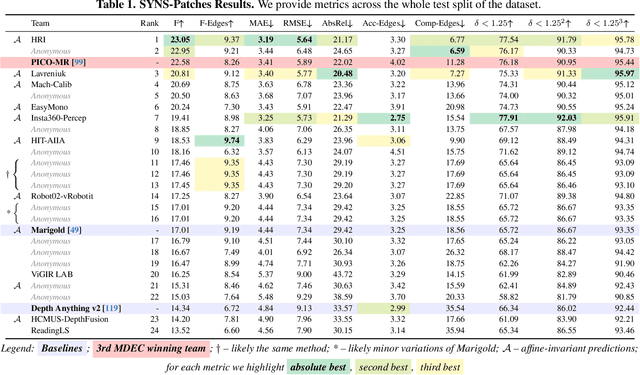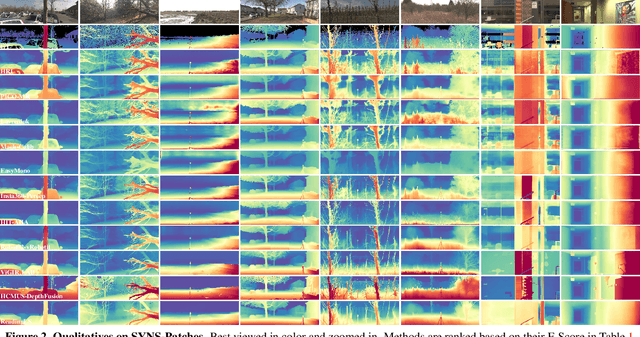Matteo Poggi
FoundationSLAM: Unleashing the Power of Depth Foundation Models for End-to-End Dense Visual SLAM
Dec 31, 2025Abstract:We present FoundationSLAM, a learning-based monocular dense SLAM system that addresses the absence of geometric consistency in previous flow-based approaches for accurate and robust tracking and mapping. Our core idea is to bridge flow estimation with geometric reasoning by leveraging the guidance from foundation depth models. To this end, we first develop a Hybrid Flow Network that produces geometry-aware correspondences, enabling consistent depth and pose inference across diverse keyframes. To enforce global consistency, we propose a Bi-Consistent Bundle Adjustment Layer that jointly optimizes keyframe pose and depth under multi-view constraints. Furthermore, we introduce a Reliability-Aware Refinement mechanism that dynamically adapts the flow update process by distinguishing between reliable and uncertain regions, forming a closed feedback loop between matching and optimization. Extensive experiments demonstrate that FoundationSLAM achieves superior trajectory accuracy and dense reconstruction quality across multiple challenging datasets, while running in real-time at 18 FPS, demonstrating strong generalization to various scenarios and practical applicability of our method.
StereoSpace: Depth-Free Synthesis of Stereo Geometry via End-to-End Diffusion in a Canonical Space
Dec 11, 2025Abstract:We introduce StereoSpace, a diffusion-based framework for monocular-to-stereo synthesis that models geometry purely through viewpoint conditioning, without explicit depth or warping. A canonical rectified space and the conditioning guide the generator to infer correspondences and fill disocclusions end-to-end. To ensure fair and leakage-free evaluation, we introduce an end-to-end protocol that excludes any ground truth or proxy geometry estimates at test time. The protocol emphasizes metrics reflecting downstream relevance: iSQoE for perceptual comfort and MEt3R for geometric consistency. StereoSpace surpasses other methods from the warp & inpaint, latent-warping, and warped-conditioning categories, achieving sharp parallax and strong robustness on layered and non-Lambertian scenes. This establishes viewpoint-conditioned diffusion as a scalable, depth-free solution for stereo generation.
Depth AnyEvent: A Cross-Modal Distillation Paradigm for Event-Based Monocular Depth Estimation
Sep 18, 2025Abstract:Event cameras capture sparse, high-temporal-resolution visual information, making them particularly suitable for challenging environments with high-speed motion and strongly varying lighting conditions. However, the lack of large datasets with dense ground-truth depth annotations hinders learning-based monocular depth estimation from event data. To address this limitation, we propose a cross-modal distillation paradigm to generate dense proxy labels leveraging a Vision Foundation Model (VFM). Our strategy requires an event stream spatially aligned with RGB frames, a simple setup even available off-the-shelf, and exploits the robustness of large-scale VFMs. Additionally, we propose to adapt VFMs, either a vanilla one like Depth Anything v2 (DAv2), or deriving from it a novel recurrent architecture to infer depth from monocular event cameras. We evaluate our approach with synthetic and real-world datasets, demonstrating that i) our cross-modal paradigm achieves competitive performance compared to fully supervised methods without requiring expensive depth annotations, and ii) our VFM-based models achieve state-of-the-art performance.
Lost in Translation? Vocabulary Alignment for Source-Free Domain Adaptation in Open-Vocabulary Semantic Segmentation
Sep 18, 2025



Abstract:We introduce VocAlign, a novel source-free domain adaptation framework specifically designed for VLMs in open-vocabulary semantic segmentation. Our method adopts a student-teacher paradigm enhanced with a vocabulary alignment strategy, which improves pseudo-label generation by incorporating additional class concepts. To ensure efficiency, we use Low-Rank Adaptation (LoRA) to fine-tune the model, preserving its original capabilities while minimizing computational overhead. In addition, we propose a Top-K class selection mechanism for the student model, which significantly reduces memory requirements while further improving adaptation performance. Our approach achieves a notable 6.11 mIoU improvement on the CityScapes dataset and demonstrates superior performance on zero-shot segmentation benchmarks, setting a new standard for source-free adaptation in the open-vocabulary setting.
StereoCarla: A High-Fidelity Driving Dataset for Generalizable Stereo
Sep 16, 2025Abstract:Stereo matching plays a crucial role in enabling depth perception for autonomous driving and robotics. While recent years have witnessed remarkable progress in stereo matching algorithms, largely driven by learning-based methods and synthetic datasets, the generalization performance of these models remains constrained by the limited diversity of existing training data. To address these challenges, we present StereoCarla, a high-fidelity synthetic stereo dataset specifically designed for autonomous driving scenarios. Built on the CARLA simulator, StereoCarla incorporates a wide range of camera configurations, including diverse baselines, viewpoints, and sensor placements as well as varied environmental conditions such as lighting changes, weather effects, and road geometries. We conduct comprehensive cross-domain experiments across four standard evaluation datasets (KITTI2012, KITTI2015, Middlebury, ETH3D) and demonstrate that models trained on StereoCarla outperform those trained on 11 existing stereo datasets in terms of generalization accuracy across multiple benchmarks. Furthermore, when integrated into multi-dataset training, StereoCarla contributes substantial improvements to generalization accuracy, highlighting its compatibility and scalability. This dataset provides a valuable benchmark for developing and evaluating stereo algorithms under realistic, diverse, and controllable settings, facilitating more robust depth perception systems for autonomous vehicles. Code can be available at https://github.com/XiandaGuo/OpenStereo, and data can be available at https://xiandaguo.net/StereoCarla.
FlowSeek: Optical Flow Made Easier with Depth Foundation Models and Motion Bases
Sep 05, 2025



Abstract:We present FlowSeek, a novel framework for optical flow requiring minimal hardware resources for training. FlowSeek marries the latest advances on the design space of optical flow networks with cutting-edge single-image depth foundation models and classical low-dimensional motion parametrization, implementing a compact, yet accurate architecture. FlowSeek is trained on a single consumer-grade GPU, a hardware budget about 8x lower compared to most recent methods, and still achieves superior cross-dataset generalization on Sintel Final and KITTI, with a relative improvement of 10 and 15% over the previous state-of-the-art SEA-RAFT, as well as on Spring and LayeredFlow datasets.
Stereo 3D Gaussian Splatting SLAM for Outdoor Urban Scenes
Jul 31, 2025Abstract:3D Gaussian Splatting (3DGS) has recently gained popularity in SLAM applications due to its fast rendering and high-fidelity representation. However, existing 3DGS-SLAM systems have predominantly focused on indoor environments and relied on active depth sensors, leaving a gap for large-scale outdoor applications. We present BGS-SLAM, the first binocular 3D Gaussian Splatting SLAM system designed for outdoor scenarios. Our approach uses only RGB stereo pairs without requiring LiDAR or active sensors. BGS-SLAM leverages depth estimates from pre-trained deep stereo networks to guide 3D Gaussian optimization with a multi-loss strategy enhancing both geometric consistency and visual quality. Experiments on multiple datasets demonstrate that BGS-SLAM achieves superior tracking accuracy and mapping performance compared to other 3DGS-based solutions in complex outdoor environments.
Ov3R: Open-Vocabulary Semantic 3D Reconstruction from RGB Videos
Jul 29, 2025



Abstract:We present Ov3R, a novel framework for open-vocabulary semantic 3D reconstruction from RGB video streams, designed to advance Spatial AI. The system features two key components: CLIP3R, a CLIP-informed 3D reconstruction module that predicts dense point maps from overlapping clips while embedding object-level semantics; and 2D-3D OVS, a 2D-3D open-vocabulary semantic module that lifts 2D features into 3D by learning fused descriptors integrating spatial, geometric, and semantic cues. Unlike prior methods, Ov3R incorporates CLIP semantics directly into the reconstruction process, enabling globally consistent geometry and fine-grained semantic alignment. Our framework achieves state-of-the-art performance in both dense 3D reconstruction and open-vocabulary 3D segmentation, marking a step forward toward real-time, semantics-aware Spatial AI.
NTIRE 2025 Challenge on HR Depth from Images of Specular and Transparent Surfaces
Jun 06, 2025Abstract:This paper reports on the NTIRE 2025 challenge on HR Depth From images of Specular and Transparent surfaces, held in conjunction with the New Trends in Image Restoration and Enhancement (NTIRE) workshop at CVPR 2025. This challenge aims to advance the research on depth estimation, specifically to address two of the main open issues in the field: high-resolution and non-Lambertian surfaces. The challenge proposes two tracks on stereo and single-image depth estimation, attracting about 177 registered participants. In the final testing stage, 4 and 4 participating teams submitted their models and fact sheets for the two tracks.
The Fourth Monocular Depth Estimation Challenge
Apr 24, 2025


Abstract:This paper presents the results of the fourth edition of the Monocular Depth Estimation Challenge (MDEC), which focuses on zero-shot generalization to the SYNS-Patches benchmark, a dataset featuring challenging environments in both natural and indoor settings. In this edition, we revised the evaluation protocol to use least-squares alignment with two degrees of freedom to support disparity and affine-invariant predictions. We also revised the baselines and included popular off-the-shelf methods: Depth Anything v2 and Marigold. The challenge received a total of 24 submissions that outperformed the baselines on the test set; 10 of these included a report describing their approach, with most leading methods relying on affine-invariant predictions. The challenge winners improved the 3D F-Score over the previous edition's best result, raising it from 22.58% to 23.05%.
 Add to Chrome
Add to Chrome Add to Firefox
Add to Firefox Add to Edge
Add to Edge